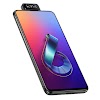To actually capture the details of a fingerprint, the hardware consists of both a transmitter and a receiver. An ultrasonic pulse is transmitted against the finger that is placed over the scanner. Some of this pulse’s pressure is absorbed and some of it is bounced back to the sensor, depending upon the ridges, pores and other details that are unique to each fingerprint.
There isn’t a microphone listening out for these returning signals. Instead, a sensor that can detect mechanical stress is used to calculate the intensity of the returning ultrasonic pulse at different points on the scanner. Scanning for longer periods of time allows for additional depth data to be captured, resulting in a highly detailed 3D reproduction of the scanned fingerprint.
There isn’t a microphone listening out for these returning signals. Instead, a sensor that can detect mechanical stress is used to calculate the intensity of the returning ultrasonic pulse at different points on the scanner. Scanning for longer periods of time allows for additional depth data to be captured, resulting in a highly detailed 3D reproduction of the scanned fingerprint.
As will all biometric security systems, processing and security highly sensitive personal information security are key. Qualcomm’s processors are built with dedicated security tools, including Cryptographic Accelerators, Key Provisioning Security, and a Trusted Execution Environment. This ensures that the processing and storage of sensitive data are kept well away from malicious applications. Other Arm-based processors offer TrustZone hardware isolation for similar levels of protection.
Qualcomm’s setup is also designed to support the Fast Identity Online (FIDO) Alliance protocols, which can be used for online password-less authentication. FIDO does this without transferring any of the confidential fingerprint information to the cloud or through networks that could be compromised.
Qualcomm’s setup is also designed to support the Fast Identity Online (FIDO) Alliance protocols, which can be used for online password-less authentication. FIDO does this without transferring any of the confidential fingerprint information to the cloud or through networks that could be compromised.
Qualcomm notes that there’s about a 250-millisecond latency for unlocking, roughly equivalent to capacitive fingerprint scanners. The sensor has about a 1 percent error rate, which again is pretty comparable to other scanners.
Qualcomm supplies ultrasonic fingerprint sensors for Samsung’s Galaxy S10 and Galaxy Note10 smartphones. But iPhones could use an even more advanced version of the technology by 2020 or 2021 rolls in.
JP Morgan analyst Samik Chatterjee believes, Apple will release a 5.4-inch iPhone, two 6.1-inch iPhones and one 6.7-inch iPhone with 5G connectivity in 2020.
Chatterjee predicts the company may introduce two high-end models (one 6.1-inch and one 6.7-inch) with support for mmWave, as well as a triple-lens camera and “world facing” 3D sensing for improved augmented reality capabilities.
While, two low-end models (6.1-inch, 5.4-inch) will not have mmWave or World facing 3D sensing, and will have a dual-lens camera.
As per the report, Apple may use Qualcomm’s X55 modems in all its 2020 iPhones, which support both mmWave and sub-6GHz spectrum.
All four iPhone models will have OLEDs. Apple might be using OLED displays from Samsung that are thinner than the displays currently being used.







0 Comments
Please do not enter any spam link in this comment box.